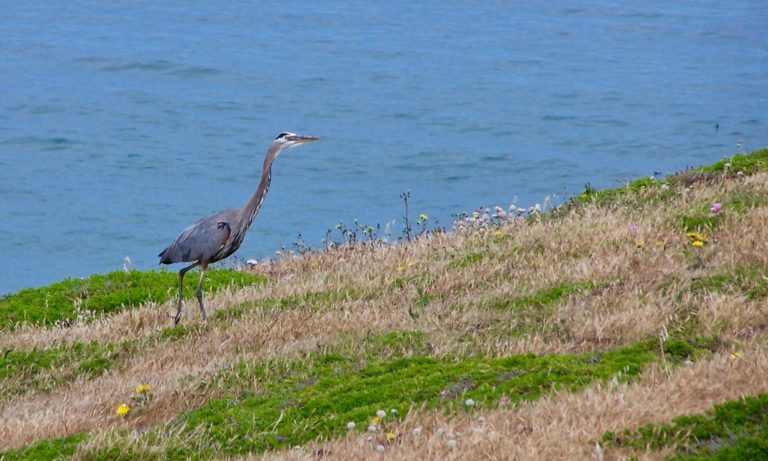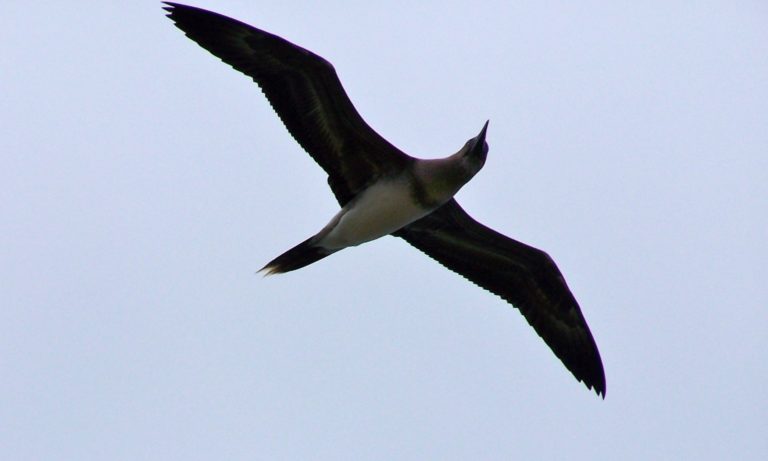On the Road is a weekday feature spotlighting reader photo submissions.
From the exotic to the familiar, whether you’re traveling or in your own backyard, we would love to see the world through your eyes.
TheOtherHank
Now that I’ve exhausted my presentable raptor pictures, here are a few more snaps of birds that one finds near water. I’ve also gotten more aware of the resolution of the image files when they get posted, so this batch is a bit more tightly cropped.

Here we see a brown pelican hoping to have a snack in the very near future.

A blue heron not looking for fish. There are a lot of them around Pacifica and I see them hunting gophers quite often so I suspect that this one looking for something mammalian.
Mori Point, for those of you who like old movies, is where Harold sends the Jaguar off the cliff into the ocean in Harold and Maude.

Several years ago we went to Kauai, there’s a lighthouse on a point that all the tourists must go to. There are many seabirds flying around, this is one of them. I don’t have any idea what it is

Another mystery seabird zooming around by the lighthouse

Some kind of wading bird. I tried to ID it using the internet and maybe it’s a long-billed curlew.

This is, I’m pretty sure, a great egret. According to the internet: cattle egrets have light colored legs and yellow bills; snowy egrets have black legs and bills; great egrets have black legs and yellow bills. Based on those options, I’m going with great egret.

A herd of brown pelicans cruising over some dunes by the beach somewhere between Half Moon Bay and Pescadero

Another blue heron, this one in Oregon and doing proper heron behavior: looking for a fish to eat.

Betty Cracker
Nice! Ever tried the Merlin Bird ID app? Their photo ID thing might be able to help you identify the mystery birds. I’ve found it extremely handy, though not 100% reliable every time.
Rob
Nice indeed! I like the blue heron photo a lot. The two Hawaiian seabirds are boobies of some sort. The Santa Barbara wading bird is a Whimbrel, a type of curlew that has head stripes.
Laura Too
These are awesome! I love the blue heron looking for gophers. I didn’t know they did that. Thanks!
Albatrossity
Cool! No idea about the seabirds; they are too dark to get much information from. When shooting birds against a bright sky it is best to overexpose the shot by 0.7 to 1.0 f/stops. Yo get a lot more detail on the birds if you do that.
The shorebird is a Whimbrel. Long-billed Curlews would have even longer bills than that!
TheOtherHank
Thanks for the whimbrel and boobie IDs. I have messed around with Merlin, but I did not know you can show it a picture. I’ll have to give that a try.
cope
These are fun pictures. As for the landlubber heron, here in The Mildew State, we get lots of birds that would normally be found at water’s edge foraging in our yards and along the roads. Not usually herons but ibises and egrets will visit our hedges and yard, probably taking advantage of the countless anoles we have in these parts.
On a side note, as an occasional submitter of pictures to BJ, can you clarify your comment about resolution issues when posting here? Are you saying you crop the picture area down so as to be able to up the pixel count for sharper pics? Just curious.
Thank you for posting these calming shots.
Barbara
These are lovely. Thanks.
mvr
Thank you!
Benw
The great egret is great! Thanks for sharing
frosty
@Albatrossity: My approach to underexposed shots has been to lighten the image in the computer. I haven’t figured out spot metering/exposure yet and so far I’m too slow for manual.
frosty
@Betty Cracker: For me, Merlin is like having an expert looking over my shoulder. Occasionally it’s laughably wrong, though, like when its only suggestion for a Muscovy Duck was Pileated Woodpecker. Wha???
TheOtherHank
@cope: With respect to cropping, when I’m looking at a picture that takes up most of my 27″ monitor, if the thing of interest is, say a quarter of the picture and the rest is setting the scene, it looks pretty good. With On The Road, the picture you see embedded in the post is what you get. Clicking on it doesn’t show you a larger version of the picture. So cropping the picture down to the focus of the picture prevents a lot of squinting and saying “What is that little patch of pixels supposed to be?” As an example, several of my raptor pictures should have been cropped to make the bird itself more of the image
CaseyL
I had no idea blue herons ate mammals. Sneaky little bastards!
Imagine you’re a chipmunk, going about your business looking for nuts, begging from hikers, the usual.
You see a bird nearby, but it’s just a heron – eh, fisheater, not someone you need to worry about like a hawk or eagle —
And the joke’s on you when the sneaky bastard snaps you up like an hors d’oeuvres at a film premiere.
cope
@TheOtherHank: Thanks.
J R in WV
This is always great stuff, both the photos and the conversation about the photos. Have been all over the world right here on Balloon-Juice, thanks to Alain and Watergurl and all the phtographers sending in their stuff.
Thanks T’ O’ Hank.
A woman from anywhere (formerly Mohagan)
I always think of the Great Egret as a Great White Heron. I can’t imagine why it isn’t called that! Obviously, I’m not clear on the difference between egrets and herons :-). Snowy Egrets are usually smaller than the Great Egrets and have what the bird books call “golden slippers” i.e. yellow feet. So if the bird has yellow feet, it’s a Snowy. Thanks for the pictures
ETA: an hour since the last post. Guess it’s dead, sigh.
frosty
@A woman from anywhere (formerly Mohagan): But there IS a Great White Heron in South Florida. White morph of a Great Blue.
See, you didn’t kill the thread!
TheOtherHank
@CaseyL: I saw a Great Blue Heron catch a gopher while I was waiting for my kids to finish swim practice. The gopher did not appreciate it at all. At least when one gets grabbed by a hawk, there’s time to die before one gets ingested. The heron’s gopher was still wriggling as it got swallowed.